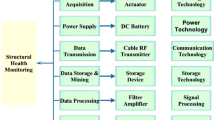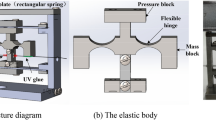Abstract
Robots with linear motion provide high accuracy and repeatability for industrial automation but may perform lower precision and stability when working long hours because of mechanical vibrations and thermal deformation caused by internal motors and ball screws. Structural health monitoring (SHM) can identify the discrepancy and avoid unexpected downtime costs, but electromagnetic interference (EMI) from the motor lowers the signal-to-noise ratio (SNR) of conventional wired sensors and may invalidate the feedback controller. This study presents an SHM system based on optical fiber Bragg grating (FBG) sensors, which provide accurate time-deformation relations and frequency spectrum results. The SHM-FBG system contributes to preventative maintenance and compares the dynamic signal of six selected points on a linear robot. The experiments also consider the boundary condition of (a) with spring loading and (b) without spring loading. Short message services (SMS) based on the long-term evolution (LTE) cellular network have converted the linear robot into an internet of things (IoT) device. The SHM-FBG system is designed to provide long-term observation of the electro-mechanical system and will send a short message to the administrator if mechanical vibrations or thermal deformations exceed predefined limits and detect acoustic emission of components before systematic failure.











Similar content being viewed by others
References
Almaiah MA, Hajjej F, Ali A, Pasha MF, Almomani O (2022) A novel hybrid trustworthy decentralized authentication and data preservation model for digital healthcare IoT based CPS. Sensors 22(4):1448
Liu YK, Ong SK, Nee AYC (2022) State-of-the-art survey on digital twin implementations. Adv Manuf 10(1):1–23
Scuro C, Lamonaca F, Porzio S, Milani G, Olivito RS (2021) Internet of things (IoT) for masonry structural health monitoring (SHM): overview and examples of innovative systems. Constr Build Mater 290(123092):123092
Ochella S, Shafiee M, Dinmohammadi F (2022) Artificial intelligence in prognostics and health management of engineering systems. Eng Appl Artif Intell 108(104552):104552
Mata J, Santos J, Barateiro J (2022) Using emergent technologies on the structural health monitoring and control of critical infrastructures. Structural Integrity. Springer International Publishing, Cham, pp 541–567
Abhijith VS, Sowmiya B, Sudersan S, Thangavel M, Varalakshmi P (2022) A review on security issues in healthcare cyber-physical systems. Cyber Intelligence and Information Retrieval. Springer Singapore, Singapore, pp 37–48 (Lecture Notes in Networks and Systems)
Doghri W, Saddoud A, Fourati LC (2022) Cyber-physical systems for structural health monitoring: sensing technologies and intelligent computing. J Supercomput 78(1):766–809
Ranasinghe K, Sabatini R, Gardi A, Bijjahalli S, Kapoor R, Fahey T, Thangavel K (2022) Advances in integrated system health management for mission-essential and safety-critical aerospace applications. Prog Aerosp Sci 128(100758):100758
Panwar NG, Singh S, Garg A, Gupta AK, Gao L (2021) Recent advancements in battery management system for Li-ion batteries of electric vehicles: future role of digital twin, cyber-physical systems, battery swapping technology, and nondestructive testing. Energ Technol 9(8):2000984
Lee J, Azamfar M, Singh J, Siahpour S (2020) Integration of digital twin and deep learning in cyber-physical systems: towards smart manufacturing. IET Collab Intell Manuf 2(1):34–36
Ante L (2021) Digital twin technology for smart manufacturing and Industry 4.0: a bibliometric analysis of the intellectual structure of the research discourse. Manuf Lett 27:96–102
Khalil A, Al Janaideh M, Aljanaideh K, Kundur D (2022) Transmissibility-based health monitoring of the future connected autonomous vehicles networks. IEEE Trans Veh Technol 71:3633–3647
Zonzini F, Aguzzi C, Gigli L, Sciullo L, Testoni N, De Marchi L, Di Felice M, Cinotti TS, Mennuti C, Marzani A (2020) Structural health monitoring and prognostic of industrial plants and civil structures: a sensor to cloud architecture. IEEE Instrum Meas Mag 23(9):21–27
Li C, Sun L, Xu Z, Wu X, Liang T, Shi W (2020) Experimental investigation and error analysis of high precision FBG displacement sensor for structural health monitoring. Int J Struct Stab Dyn 20(06):2040011
Wang YW, Ni YQ, Wang X (2020) Real-time defect detection of high-speed train wheels by using Bayesian forecasting and dynamic model. Mech Syst Signal Process 139(106654):106654
Presti DL, Massaroni C, Leitão CS, Domingues MD, Sypabekova M, Barrera D, Floris I et al (2020) Fiber Bragg gratings for medical applications and future challenges: a review. IEEE Access Pract Innov Open Solut 8:156863–156888
Massaroni C, Zaltieri M, Presti DL, Nicolo A, Tosi D, Schena E (2021) Fiber Bragg grating sensors for cardiorespiratory monitoring: a review. IEEE Sens J 21(13):14069–14080
Vorathin E, Hafizi ZM, Ismail N, Loman M (2020) Review of high sensitivity fibre-optic pressure sensors for low pressure sensing. Opt Laser Technol 121(105841):105841
Xiong L, Guo Y, Jiang G, Zhou X, Jiang L, Liu H (2021) Six-dimensional force/torque sensor based on fiber Bragg gratings with low coupling. IEEE Trans Ind Electron 68(5):4079–4089
Li T, Guo J, Tan Y, Zhou Z (2020) Recent advances and tendency in fiber Bragg grating-based vibration sensor: a review. IEEE Sens J 20(20):12074–12087
Gao X, Ning T, Zhang C, Xu J, Zheng J, Lin H, Li J, Pei L, You H (2020) A dual-parameter fiber sensor based on few-mode fiber and fiber Bragg grating for strain and temperature sensing. Optics Commun 454(124441):124441
Zhao J, Xu J, Wang C, Liu Y, Yang Z (2020) Experimental demonstration of multi-parameter sensing based on polarized interference of polarization-maintaining few-mode fibers. Opt Express 28(14):20372–20378
Puttnam BJ, Rademacher G, Luís RS (2021) Space-division multiplexing for optical fiber communications. Optica 8(9):1186
Su Y, He Y, Chen H, Li X, Li G (2021) Perspective on mode-division multiplexing. Appl Phys Lett 118(20):200502
Farooq B, Bao J, Li J, Liu T, Yin S (2020) Data-driven predictive maintenance approach for spinning cyber-physical production system. J Shanghai Jiaotong Univ 25(4):453–462
Funding
The authors gratefully acknowledge financial support for this research from the Ministry of Science and Technology (Republic of China) under Grant MOST 109–2221-E-002-MY3.
Author information
Authors and Affiliations
Contributions
Hsiang-Wei Ho and Wei-Hsiang Liao contribute to the mathematical model and numerical analysis. Ching-Yuan Chang contributes to the experimental setup and data collection. Chien-Ching Ma contributes to the main structure of this research.
Corresponding author
Ethics declarations
Ethics approval
The grant’s policy encourages researchers to broaden industrial automation applications and to publish the latest research in a reputable journal. It is a novel contribution to the scientific literature that has not been published elsewhere previously or simultaneously in whole or in part.
Conflicts of interest
Since the funding comes from our government, there are no conflicts of interest, competing interests, and ethical issues involved in this academic research.
Additional information
Publisher's Note
Springer Nature remains neutral with regard to jurisdictional claims in published maps and institutional affiliations.
Rights and permissions
Springer Nature or its licensor holds exclusive rights to this article under a publishing agreement with the author(s) or other rightsholder(s); author self-archiving of the accepted manuscript version of this article is solely governed by the terms of such publishing agreement and applicable law.
About this article
Cite this article
Ho, HW., Liao, WH., Chang, CY. et al. Structural health monitoring of a linear robot by fiber Bragg grating sensors and cyber-physical system. Int J Adv Manuf Technol 122, 3983–3995 (2022). https://doi.org/10.1007/s00170-022-10066-w
Received:
Accepted:
Published:
Issue Date:
DOI: https://doi.org/10.1007/s00170-022-10066-w




